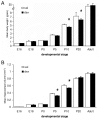Antenatal glucocorticoid treatment affects hippocampal development in mice
- PMID: 24465645
- PMCID: PMC3899077
- DOI: 10.1371/journal.pone.0085671
Antenatal glucocorticoid treatment affects hippocampal development in mice
Abstract
Synthetic glucocorticoids are administered to pregnant women at risk for preterm delivery, to enhance fetal lung maturation. The benefit of this treatment is well established, however caution is necessary because of possible unwanted side effects on development of different organ systems, including the brain. Actions of glucocorticoids are mediated by corticosteroid receptors, which are highly expressed in the hippocampus, a brain structure involved in cognitive functions. Therefore, we analyzed the effects of a single antenatal dexamethasone treatment on the development of the mouse hippocampus. A clinically relevant dose of dexamethasone (0.4 mg/kg) was administered to pregnant mice at embryonic day 15.5 and the hippocampus was analyzed from embryonic day 16 until adulthood. We investigated the effects of dexamethasone treatment on anatomical changes, apoptosis and proliferation in the hippocampus, hippocampal volume and on total body weight. Our results show that dexamethasone treatment reduced body weight and hippocampal volume transiently during development, but these effects were no longer detected at adulthood. Dexamethasone treatment increased the number of apoptotic cells in the hippocampus until birth, but postnatally no effects of dexamethasone treatment on apoptosis were found. During the phase with increased apoptosis, dexamethasone treatment reduced the number of proliferating cells in the subgranular zone of the dentate gyrus. The number of proliferative cells was increased at postnatal day 5 and 10, but was decreased again at the adult stage. This latter long-term and negative effect of antenatal dexamethasone treatment on the number of proliferative cells in the hippocampus may have important implications for hippocampal network function.
Conflict of interest statement
Figures






References
-
- Zarrow MX, Philpott JE, Denenberg VH (1970) Passage of 14C-4-corticosterone from the rat mother to the foetus and neonate. Nature 226: 1058–1059. - PubMed
-
- Meijer OC, de Kloet ER (1998) Corticosterone and serotonergic neurotransmission in the hippocampus: Functional implications of central corticosteroid receptor diversity. Crit Rev Neurobiol 12: 1–20. - PubMed
-
- Coe CL, Kramer M, Czeh B, Gould E, Reeves AJ, et al. (2003) Prenatal stress diminishes neurogenesis in the dentate gyrus of juvenile rhesus monkeys. Biol Psychiatry 54: 1025–1034. - PubMed
Publication types
MeSH terms
Substances
LinkOut - more resources
Full Text Sources
Other Literature Sources
Medical

